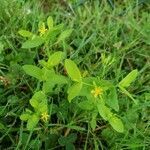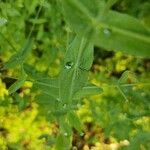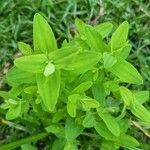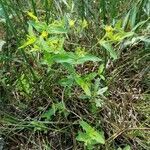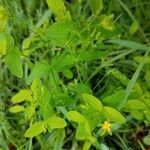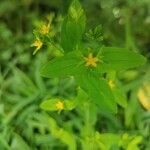Slender, erect, annual or perennial, glabrous herb, to c. 40 cm tall, lacking black glands. Stems 4-angled, simple or branched above the middle, often rooting near the base. Lvs sessile, 7-27-(33) × 4-13 mm, ovate to oblong, prominently pellucid-glandular beneath; base broad-cuneate to subcordate and ± amplexicaul; apex obtuse. Panicles terminal, few-to many-flowered; bracts and bracteoles 1-2 mm long, subulate. Sepals slightly unequal, 2-3 mm long, somewhat longer at fruiting, lanceolate to oblong, entire, with pellucid glands; apex acute. Corolla 3-4 mm diam., pale yellow; petals ± broad-elliptic, < sepals. Stamens c. 10 and not in evident bundles, < petals. Styles 3, 0.4-0.5 mm long, much < ovary. Capsule c. 4 mm long, oblong-ellipsoid, dry. Seeds 0.4-0.5 mm long, cylindric, very finely reticulate and with 2 longitudinal ribs.
Erect annual or perennial 1–8 dm, usually much-branched above; lvs lanceolate to elliptic or ovate, 1–4 cm, obtuse to subacute, broadly obtuse to rounded at base, 3–5-nerved; infl commonly widely much-branched; bracteal lvs subulate, 1–4 mm; sep linear-oblong, acute, about equaling the fr; pet 1.5–2.5 mm; stamens 5–16; styles 3, under 1 mm; fr green, ellipsoid, unilocular, 2–3.5 mm; seeds 0.4–0.7 mm; 2n=16. Wet soil; Nf. and Que. to Man., s. to Fla. and Tex. July–Sept. (H. parviflorum)
